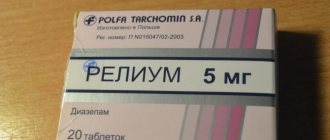Instructions for use of Neurox
The drug is widely used for diseases of the central nervous system, but also as part of complex therapy for pathologies of other body systems (glaucoma, myocardial infarction, etc.). It is produced by a Russian pharmacological company. The medicine has become widespread due to a large list of indications for use, a small number of severe adverse reactions and a low likelihood of overdose.
Composition and release form
A solution is produced for intramuscular and intravenous administration. Externally: transparent, colorless or yellowish. Light-protective, dark-colored ampoules in blister packs contain 2 ml or 5 ml of the substance. Detailed composition of the drug:
| Components | Substance name | Dosage | |
| in 1 ml | In 1 ampoule | ||
| Basic | ethylmethylhydroxypyridine succinate | 50 mg | 1000 mg |
| Auxiliary | sodium disulfite | 1 mg | |
| water for injections | up to 1 ml | ||
pharmachologic effect
Neurox has a wide spectrum of effects on the human nervous system. The main ones include:
- membrane-protective effect (the drug helps protect the membranes of neurons (brain cells) from the adverse effects of various factors;
- nootropic effect (affects the activation of human mental activity);
- anticonvulsant effect (reduces the risk of seizures);
- antihypoxic effect (reduces the need of neurons for oxygen by improving blood supply to the brain);
- anxiolytic effect (helps increase stress resistance);
- eliminates feelings of anxiety, tension and relieves fears.
Pharmacodynamics and pharmacokinetics
Antioxidant drug Neurox with the active ingredient ethylmethylhydroxypyridine succinate (EMHPS). The mechanism of action is based on suppressing lipid peroxidation, increasing peroxidase activity, improving the structure and function of cell membranes (due to the transport of oxygen and neurotransmitters - substances that transmit information in brain cells). In the cell, mitochondrial function is activated and the degree of inhibition of oxidation under hypoxic conditions decreases due to an increase in creatine phosphate and adenosine triphosphoric acid.
Neurox increases the concentration of dopamine in brain cells, thereby increasing stress resistance (normalization of autonomic disorders) and mental activity, reducing anxiety and convulsive readiness. Due to its antitoxic effect, the drug is used for alcohol intoxication, withdrawal syndrome, or overdose of medications that depress the functioning of the central nervous system.
The drug increases the body's resistance in various pathological conditions (shock, hypoxia, ischemia, alcohol intoxication) from the influence of unfavorable destructive factors. Under its influence, microcirculation and blood properties improve, platelet aggregation decreases, thereby reducing the risk of developing thrombosis. The active substance reduces cholesterol and lipoprotein levels, thereby reducing the risk of recurrent heart attack or stroke.
When administered intramuscularly, the drug can be detected in the blood after 4 hours, and after intravenous administration within 30–40 minutes. The active substance quickly passes from blood vessels to organ tissues, then breaks down into metabolites in the liver. More than 50% is excreted in the urine during the first 5 hours after administration. The rate of elimination of the unchanged drug depends on the individual characteristics of the body.
Indications for use of the drug Neurox
The scope of application in neurology of this medicine is very wide. The main indications for use include:
- treatment after traumatic brain injury;
- neurological disorders due to atherosclerosis (mild cognitive impairment);
- neuroses and mental illnesses (anxiety, tension);
- encephalopathy of various origins;
- cerebrovascular accidents, such as ischemic stroke;
- in complex treatment with other drugs for myocardial infarction;
- anxiety syndrome in neurotic and neurosis-like conditions;
- alcohol intoxication;
- vegetative-vascular dystonia syndrome;
- primary glaucoma of different stages (as part of complex therapy);
- withdrawal syndrome in chronic alcoholism;
- overdose of neuroleptics (antipsychotic drugs).
Why are Neurox injections prescribed?
Indications for the use of Neurox and drug analogues are the following pathological conditions:
- acute disruption of the blood supply to brain tissue (as part of complex therapeutic regimens);
- anxiety disorders arising against the background of neuroses and neurotic diseases;
- primary open-angle glaucoma of any severity (in combination with other drugs);
- vegetative-vascular dystonia;
- withdrawal syndrome that occurs with systematic alcohol consumption, accompanied by neurosis-like disorders and vegetative-vascular disorders;
- dyscirculatory and alcoholic encephalopathy;
- recent heart attack (treatment begins in the first hours after the attack occurs in combination with other therapeutic agents);
- complications of traumatic brain injury;
- cognitive disorders caused by atherosclerotic lesions of cerebral vessels (with a mild course of the disease);
- poisoning with antipsychotic drugs.
Contraindications for use
The drug Neurox is not used for the following physiological and pathological conditions:
- allergy to the components of the solution;
- During pregnancy and breastfeeding;
- severe heart failure.
Directions for use and dosage
The drug Neurox is administered intramuscularly or intravenously. For drip administration, the drug is diluted in 150 ml of saline or 5% dextrose (glucose) solution, the infusion rate is 50 drops per minute. It should be injected into a vein very slowly over 4-5 minutes. The exact dosage is selected by the attending physician depending on the severity of the disease and the general condition of the patient.
It is recommended to start treatment with Neurox 50-300 mg per day. A large dose (more than 50 mg) should be distributed over 2 to 3 injections. For a therapeutic effect, the dosage is gradually increased. The maximum daily dose is 800 mg, and a single dose is 250 mg. Treatment takes place in courses from 5 days to 1 month. If necessary, the doctor, according to the patient’s indications, can extend it.
- Nogtivit - instructions for use
- Thirty-third week of pregnancy
- How to remove paint from clothes
Pharmacological properties
Pharmacodynamics
EMHPS belongs to 3-hydroxypyridines. It inhibits free radical processes and is a membrane protector with nootropic, antihypoxic, anticonvulsant, stress-protective and anxiolytic activity. The mechanism of its action is associated with membrane protective and antioxidant properties. EMGPS inhibits the process of lipid peroxidation, enhances the activity of the enzyme superoxide dismutase, increases the lipid/protein ratio, and also improves the function and structure of the cell membrane. The drug modulates the activity of receptor complexes and membrane-bound enzymes, promoting their binding to ligands, improving transmission between synapses and preserving the structure and function of biological membranes and neurotransmitter transport. Under the influence of EMGPS, the concentration of the hormone dopamine in the brain increases. Under conditions of oxygen starvation, it increases the compensatory activation of aerobic glycolysis and reduces the degree of inhibition of oxidation processes in the Krebs cycle.
In case of cerebrovascular accidents, ischemia and hypoxia, shock, intoxication with antipsychotic drugs and ethanol, Neurox increases the body's resistance to the influence of various damaging factors. It improves microcirculation, blood supply and metabolism in the brain, blood rheology, and reduces platelet aggregation. The drug stabilizes the membranes of red blood cells and platelets, resulting in a reduced likelihood of hemolysis. The lipid-lowering effect is manifested by a decrease in the content of total cholesterol and low-density lipoproteins.
In case of myocardial ischemia, Neurox reduces the area of necrosis, normalizes metabolism in the heart muscle, improves and/or restores contractility and electrical activity of the myocardium, increases coronary blood flow, enhances the antianginal effect of nitro drugs and neutralizes the consequences of reperfusion syndrome in patients with acute coronary insufficiency.
The stress-protective effect of the drug is manifested in the restoration of impaired memory and learning processes, sleep-wake cycles, normalization of somatovegetative disorders and behavior after stress, and reduction of dystrophic changes in brain structures.
In case of withdrawal syndrome, EMGPS has a pronounced antitoxic effect. It eliminates the neurotoxic and neurological manifestations of alcohol poisoning, and also corrects decreased memory and mental performance and behavioral disorders.
EMGPS enhances the effect of neuroleptic, hypnotic, tranquilizing, anticonvulsant and antidepressant drugs, which makes it possible to reduce their doses and reduce unwanted side effects.
Pharmacokinetics
After intramuscular administration, the drug is detected in the blood within 4 hours. The time to reach maximum plasma concentration is 0.3–0.58 hours. When Neurox is administered intramuscularly at a dose of 400–500 mg, the maximum plasma concentration is 2.5–4 μg/ml. The active substance of the drug quickly enters the tissues and organs from the blood and is then excreted from the body. When administered intramuscularly, EMGPS is retained in the body for about 0.7–1.3 hours.
Metabolism occurs in the liver by glucuronidation. Over 12 hours, about 50% of the administered dose is excreted in the urine in the form of metabolites and about 0.3% unchanged. The most intense elimination occurs in the first 4 hours after injection. The elimination parameters of Neurox in the form of metabolites and in unchanged form vary significantly among different patients.
Drug interactions
The effect of Neurox may vary depending on concomitant use with other medications. To avoid the development of severe adverse reactions, you should consult a specialist before use. The following drugs should be combined with caution:
- antiepileptics (Carbamazepine), antiparkinsonian (Levodopa, Carbidopa);
Neurox injections enhance the effect of these medications.
- Ethanol;
The drug reduces the toxic effect of alcohol metabolites on the body.
- benzodiazepine tranquilizer (Diazepam), nitrates (Nitroglycerin);
Neurox leads to potentiation (increased effect) of these drugs.
Indications for use
Indications for Neurox are the following diseases and conditions:
- DEP (dyscirculatory encephalopathy);
- mild cognitive impairment of atherosclerotic origin;
- acute circulatory disorders in the brain (in complex treatment);
- NCD (neurocirculatory dystonia);
- anxiety states accompanying neurosis-like and neurotic disorders;
- acute poisoning with antipsychotic drugs;
- alcohol withdrawal syndrome with a predominance of vegetative-vascular and neurosis-like disorders.
Side effects of Neurox
Most of the undesirable effects are observed with intravenous jet administration of the drug. The main adverse reactions include:
- dryness of the oral mucosa;
- sore throat;
- metallic taste in the mouth;
- feeling of warmth throughout the body;
- chest discomfort;
- feeling of lack of air;
- nausea;
- increased gas formation in the intestines (flatulence);
- intestinal colic;
- drowsiness or insomnia;
- skin itching;
- satiate.
Reviews of Neurox
The drug is quite often prescribed in the complex treatment of various neurological disorders, as well as for persons with alcohol withdrawal syndrome. According to reviews, Neurox is effective in most cases and helps improve the patient’s condition (dizziness disappears, the person feels calmer). Reviews about the ineffectiveness of the drug are rare, but there are a lot of reports that talk about the side effects of the drug (feeling hot, sore throat, severe dizziness and headaches, increased blood pressure). To reduce the risk of these side effects, it is recommended to administer the drug as slowly as possible.
Overdose
If Neurox is administered intramuscularly, no overdose is observed, but with intravenous administration, the normal dosage can be disrupted. The main symptoms of this condition: sleep problems (insomnia or, conversely, drowsiness, difficulty falling asleep), increased blood pressure. No emergency treatment is required; the symptoms will disappear on their own within a day. Sometimes, for severe insomnia, it is possible to use tranquilizers (Diazepam, Oxazepam). For hypertension, take antihypertensive drugs (β-blockers, etc.) with blood pressure control.
Pharmacodynamics and pharmacokinetics
The active ingredient Neuroxa ethylmethylhydroxypyridine succinate (EMHPS) suppresses the toxic effect of free radicals formed during the metabolic process in the human body and destroying cells and tissues. It protects the membranes (shells) of brain cells from any influences, improves their structure and function (including the transport of oxygen and neurotransmitters - substances through which information is transmitted in brain cells).
of dopamine in the brain , which is called the hormone of pleasure, increases. All this leads to an increase in stress resistance and mental abilities, a decrease in anxiety and convulsive readiness . Neurox has an antitoxic effect during acute and chronic alcohol intoxication , during withdrawal syndrome ( intoxication that develops against the background of withdrawal from alcohol in patients with chronic alcoholism ) and during an overdose of drugs affecting the central nervous system.
The duration of action of Neurox when administered intramuscularly is up to 4 hours. The maximum concentration in blood plasma occurs 20–40 minutes after administration. The active substance quickly passes from blood vessels to organs and tissues and is also quickly excreted from the body in the urine, having previously been metabolized (decomposed into metabolic products - metabolites ) in the liver.
Analogs
Neurox has a large number of analogues. Preparations with the same active ingredient include:
- Metostabil;
- Mexiprim;
- Mexidant;
- Astrox;
- Mexicofin;
- Medomexy;
- Mexidol;
- Cerecard;
- Mexican.
Analogues of Neurox, which are used to treat the same diseases of the nervous system:
- Piracetam, Phenibut (nootropics);
- Nozepam, Sibazon (tranquilizers);
- Carbamazepine (anti-epileptic drug);
- Vinpocetine (a drug to improve cerebral circulation);
- Vitamins C and E (antioxidants).
pharmachologic effect
- the drug protects the membranes of brain cells (neurons) from any influences (membranoprotective effect);
- improves blood circulation in the brain and reduces the need of neurons for oxygen (antihypoxic effect);
- has a direct activating effect on mental activity (nootropic effect);
- relieves feelings of anxiety , fear and tension ;
- increases stress resistance (anxiolytic effect);
- suppresses the development of seizures (anticonvulsant effect).
Neurox price
Average cost of the drug in Moscow pharmacies:
| Pharmacy name | Packaging price, rubles. | ||
| amp. 50 mg/ml 5 ml No. 5 | amp. 50 mg/ml 2 ml No. 10 | amp. 50 mg/ml 2 ml No. 50 | |
| ZdravCity | 307,7 | 308,7 | 1228,1 |
| Triumph | 349 | 358 | 993 |
| Sun | 298 | 375 | 964 |
| Help window | 390 | 362 | 962 |
| Economy | 332,5 | 423 | 1028 |
| Aster | 350 | 347 | 982 |
Release form and composition
Neurox is available in the form of a solution for intravenous and intramuscular administration: a clear, colorless or slightly yellowish liquid (2 ml in dark glass ampoules, five ampoules in strip packs, in a cardboard pack of 1, 2, 4 or 10 strip packs; 5 each ml in dark glass ampoules, five ampoules in blister packs, in a cardboard pack 1, 2 or 4 blister packs; 10 ml or 20 ml in dark glass ampoules, one ampoule in blister packs, in a cardboard pack 1 blister pack ).
Composition per 1 ml of solution:
- active ingredient: EMGPS (ethylmethylhydroxypyridine succinate) – 50 mg;
- auxiliary components: water for injection, sodium disulfite.
Contraindications
The drug does not have many contraindications. Before using Neurox, you should carefully read the instructions. The list of contraindications includes the following conditions and pathologies:
- pregnancy (especially 1.3 trimesters);
- lactation period (breastfeeding) in women;
- age under 18 years;
- acute renal failure (ARF);
- individual allergic reaction to the components of the drug;
- liver failure.
Side effects and drug compatibility
When treated with Neurox, dyspepsia may occur: nausea, excessive gas formation, intestinal colic. In some cases, sleep disorders such as insomnia or drowsiness are possible. If any negative effects occur, you must consult a doctor to adjust the dose or replace the drug. Although in most cases such symptoms go away on their own and do not require any special treatment measures.
Neurox is able to enhance the effect of benzodiazepine tranquilizers (Diazepam), as well as antiepileptic antiparkinsonian drugs. Reduces toxic reactions after drinking alcohol.
Medicine Neurox - contraindications for use
Neurox cannot be used for the following diseases and conditions:
- severe diseases accompanied by acute impairment of kidney or liver function ( acute renal and liver failure );
- pregnancy and breastfeeding;
- increased sensitivity of the body to the components of the drug;
- children of any age.
Neurox is used with caution for allergic diseases and reactions that the patient has had in the past. During treatment, care should be taken when driving a car and performing other work that requires increased concentration and speed of response.
Neurox
Active substance:
Ethylmethylhydroxypyridine succinate
Pharmgroup:
Antihypoxants and antioxidants
Average price in pharmacies
| Name | Manufacturer | average price |
| Neurox 0.05/ml 2ml n10 amp solution i.v. i.m. | Pharm, JSC | 295.00 |
| Neurox 0.05/ml 2ml n50 amp solution i.v. i.m. | Pharm, JSC | 1148.00 |
| Neurox 0.05/ml 5ml n5 amp solution i.v. i.m. | Pharm, JSC | 294.00 |
| Neurox 0.125 n30 tablet p/capt/shell | SOTEX PHARMFIRM | 204.00 |
| Neurox 0.125 n50 tablet p/capt/shell | SOTEX PHARMFIRM | 331.00 |
Analogs for the active substance:Medomexy Mexidant Mexidol Mexiprim Mexicofin Metostabil Cerecard Ethylmethylhydroxypyridine succinate | Application area:Alcohol withdrawal syndrome Withdrawal syndrome Withdrawal syndrome in alcoholism Abstinence Alcohol withdrawal Alcohol withdrawal Alcohol withdrawal state Alcohol withdrawal syndrome Bilirubin encephalopathy Vasovegetative manifestations Vasomotor dystonia Autonomic dystonia Autonomic dysfunction Vegetative lability Autonomic-vascular disorders Autonomic disorders Vegetative-vascular dystonia Vegetative-vascular disorders Vegetovascular dystonia Vegetovascular disorders Secondary neurotic symptom Severe anxiety Hypertensive encephalopathy Hypoxic encephalopathy Brain hypoxia Delirious state in alcoholism and drug addiction Dysmetabolic encephalopathy Vegetative-vascular dystonia Neurocirculatory dystonia Encephalopathy Encephalopathy Other neurotic conditions Diseases of the brain of a vascular and age-related nature Ischemic stroke Ischemic brain disease Ischemic brain lesions Ischemic stroke Ischemic stroke and its consequences Ischemic cerebral stroke Ischemic cerebrovascular accident Ischemic brain damage Ischemic brain damage Ischemic condition Cerebral ischemia Cognitive impairment in degenerative and vascular diseases of the brain Cognitive impairment in neurotic disorders Cognitive disorder Cognitive disorders Coma due to cerebrovascular accident Correction of side effects of neuroleptics Correction of side effects of neuroleptics Lacunar status Lacunar status Latent hepatic encephalopathy Metabolic and vascular disorders of the brain Cognitive impairment Impaired blood supply to the brain Cerebrovascular accident Brain dysfunction Dysfunction of the cerebral cortex Cerebral circulation disorders Neurosis Neurosis with increased irritability Neurosis-like symptoms Neurosis-like disorders Neurosis-like conditions Neuroses Neuroses of all kinds Neuroses with retardation Neuroses with anxiety symptoms Neuroses with anxiety Neuroses of the heart Neurotic disorders in alcoholism Neurotic disorders with retardation Neurotic disorders with anxiety syndrome Neurotic disorders with anxiety syndrome Neurotic reactions Neurotic symptoms in alcoholism Neurotic conditions Neurotic syndrome Neurotic disorder Cerebrovascular insufficiency Neurovegetative disorders Neuroleptic extrapyramidal syndrome Cardiopsychoneurosis Neurocirculatory dystonia of the hypertensive type Acute brain hypoxia Acute intoxication with antipsychotic drugs Acute cerebrovascular insufficiency Acute situational and stress anxiety Acute situational stress anxiety Acute cerebral ischemia Acute ischemic cerebrovascular accident Acute cerebrovascular accident Acute cerebral infarction Acute ischemic stroke Acute period of ischemic stroke Acute anxiety attack Focal cerebral ischemia Primary neurovegetative syndrome |





